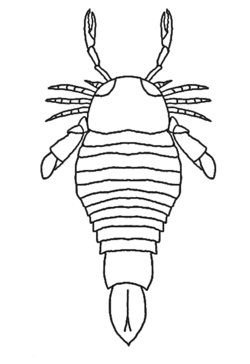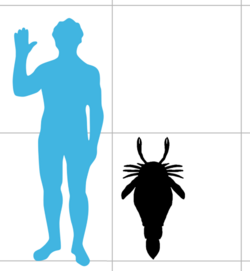Biology:Ciurcopterus
| Ciurcopterus | |
|---|---|

| |
| Fossil specimen of C. ventricosus | |

| |
| Restoration of C. ventricosus | |
| Scientific classification | |
| Domain: | Eukaryota |
| Kingdom: | Animalia |
| Phylum: | Arthropoda |
| Subphylum: | Chelicerata |
| Order: | †Eurypterida |
| Superfamily: | †Pterygotioidea |
| Family: | †Pterygotidae |
| Genus: | †Ciurcopterus Tetlie & Briggs, 2009 |
| Type species | |
| †Ciurcopterus ventricosus Kjellesvig-Waering, 1948
| |
| Species | |
| |
Ciurcopterus is a genus of eurypterid, an extinct group of aquatic arthropods. Fossils of Ciurcopterus have been discovered in deposits of Late Silurian age in North America. Classified as part of the family Pterygotidae, the genus contains two species, C. sarlei from Pittsford, New York and C. ventricosus from Kokomo, Indiana.[1] The genus is named in honor of Samuel J. Ciurca, Jr., who has contributed significantly to eurypterid research by discovering a large amount of eurypterid specimens, including the four specimens used to describe Ciurcopterus itself.[2]
Ciurcopterus is the most basal (primitive) known member of the Pterygotidae, and combined characteristics of more derived members of the family with features of close relatives of the group, such as Slimonia. Measuring 70 centimetres (28 inches) in length, Ciurcopterus was relatively large though smaller than many of the later members of its family, which would grow to become the largest known arthropods to have ever lived.
Description

Ciurcopterus was a eurypterid of medium size, with C. ventricosus measuring approximately 70 centimetres (28 in) in length and C. sarlei measuring 50 centimetres (20 in).[4] Though this is large relative to most modern day arthropods, Ciurcopterus was dwarfed by many of the members of its family (the Pterygotidae), such as Jaekelopterus rhenaniae at 2.5 metres (8 ft, the largest known arthropod) and Acutiramus bohemicus at 2.1 metres (7 ft).[5]
Ciurcopterus possessed walking legs that were similar to those of Slimonia in bearing distal serrations. The telson (the posteriormost segment of its body) was wide and possessed dorsal median carinae. The type A genital appendage (one of the morphs of eurypterid genital appendages, equipped with clasping organs) was undivided and the pretelson (the segment immediately preceding the telson), lacking dorsal median carina (keels running down the center of the dorsal side), is laterally expanded.[2]
Other than the type species C. ventricosus, defined by its quadrate (square-shaped) pretelson and the narrow and elongated telson, one other species has been assigned to the genus; C. sarlei. The telson of C. sarlei is similar to that of C. ventricosus but the pretelson is shorter and wider. Both of these species have in the past been assigned to the larger and more derived pterygotid Pterygotus.[2] Some authors have speculated that if the chelicerae of Ciurcopterus are large (they are at present unknown from the genus), many fragmentary pterygotid specimens and species known only from chelicerae could be reassigned to Ciurcopterus.[2]
Ciurcopterus is classified as part of the pterygotid family of eurypterids, a group of highly derived eurypterids of the Silurian to Devonian periods that differ from other groups by a number of features, perhaps most prominently in the chelicerae (the first pair of limbs) and the telson. The chelicerae of the Pterygotidae were enlargened and robust, clearly adapted to be used for active prey capture and more similar to the claws of some modern crustaceans, with well developed teeth on the claws, than to the chelicerae of other eurypterid groups.[6] Another feature distinguishing the group from other eurypterid groups were their flattened and expanded telsons, likely used as rudders when swimming.[7] Their walking legs were small and slender, without spines,[8] and they were likely not capable of walking on land.[5]
History of research

Ciurcopterus was first described as a species of Pterygotus, P. ventricosus, by Erik. N. Kjellesvig-Waering in 1948. This species was represented by the dorsal impression of a single incomplete fossilised individual discovered near Kokomo, Indiana. The specimen (USNM 88130, currently housed at the U.S. National Museum in Washington) preserves most of the body, excluding parts of the appendages and the end of the telson. This individual would have measured approximately 29 cm (11 in) in length in life. Kjellesvig-Waering noted that the species did not resemble any of the other North American species of Pterygotus that had been described but that it did share some similarities with the British P. anglicus, from which it could still be differentiated by the different shape of the carapace, differences in the sixth appendage and P. ventricosus exhibiting a greater gibbosity.[9]
In 2007, O. Erik Tetlie and Derek E. G. Briggs redescribed the species based on four new specimens recovered from Kokomo. The new material allowed them to determine that P. ventricosus represented the most basal pterygotid eurypterid and the study helped provide evidence for the precise phylogenetic position of the family, showing that the Slimonidae (and not the Hughmilleriidae) was the most closely related group to the Pterygotidae. The specimens included YPM 208028 (the anterior half of an individual), YPM 209622 (a telson), YPM 210975 (a genital operculum) and YPM 210974 (a pretelson).[2] Tetlie and Briggs erected a new genus due to the unique features and distinct phylogenetic position of the species, naming it Ciurcopterus in honour of Samuel J. Ciurca, Jr., who has contributed significantly to eurypterid research by discovering a large amount of eurypterid specimens, including the four new specimens used to describe Ciurcopterus itself.[2] Another species, C. sarlei (also previously classified as a species of Pterygotus) was also referred to the genus due similarities in the pretelson (which is wider and shorter than that of C. ventricosus) and telson.
Classification

Ciurcopterus has been noted as possessing a mix of features from both more primitive pterygotioids such as Slimonia and more derived members of the group firmly within the Pterygotidae. For instance, its appendages share striking similarities with those of Slimonia but its carapace and more importantly its undivided genital appendage (a characteristic of pterygotid eurypterids) places it within the Pterygotidae.[2] C. ventricosus, also referred to as the "Kokomo pterygotid" after the site of its discovery, does possess some smaller differences compared to the rest of the Pterygotidae, such as keels running down the dorsal side of the pretelson. The enlarged chelicerae and claws present in all other pterygotids are unknown in Ciurcopterus since they have as of yet not been preserved in fossils, though this does not rule out that it had them. The combination of features in Ciurcopterus demonstrates that all the diagnostic characteristics of the Pterygotidae did not appear at the same time, suggesting that the evolution of these features was gradual.[2]
The cladogram below is based on the nine best-known pterygotid species and two outgroup taxa (Slimonia acuminata and Hughmilleria socialis). The cladogram also contains the maximum sizes reached by the species in question, which have been suggested to possibly have been an evolutionary trait of the group per Cope's rule ("phyletic gigantism").[5][10]
| Pterygotioidea |
| ||||||||||||||||||||||||||||||||||||||||||||||||||||||||||||
Paleoecology
The Late Silurian Kokomo limestone that yielded the known fossils of C. ventricosus has also preserved fossil remains of numerous other eurypterid species and genera, including Erieopterus limuloides, Carcinosoma newlini, Onychopterella kokomoensis and Kokomopterus longicaudatus.[11] Fossils of various other organisms have also been recovered, including algal stromatolites, corals (such as Halysites), small cephalopods (such as Protokionoceras) and leperditiid ostracods. Two species of the conodont Spathognathodus (S. eosteinhornensis and S. snajdri) have also been recovered from the formation.[12]
The presence of stromatolites, molds of evaporate crystals and other features suggest that the Kokomo formation was primarily composed of very shallow environments.[12] Geological features of the formation, such as the argillaceous (resembling clay) limestone, suggests that the Silurian environment of the region might have been quiet and lagoonal. The bottom conditions were possibly anoxic and the environment might have been supratidal and hypersaline at large.[11]
Reconstructing the precise ecological role of Ciurcopterus may prove difficult as studies on the paleoecology of other pterygotid eurypterids have mainly focused not only on how visually acute they would have been in life, but also on the morphology of their claws and chelicerae, which are lacking in the known fossil Ciurcopterus specimens. Though derived pterygotids, such as Acutiramus, Jaekelopterus and Pterygotus, had divergent and specialized ecological roles, more basal genera, such as Erettopterus, were more generalized predators.[13]
See also
References
- ↑ Dunlop, J. A., Penney, D. & Jekel, D. 2015. A summary list of fossil spiders and their relatives. In World Spider Catalog. Natural History Museum Bern, online at http://wsc.nmbe.ch , version 16.0 http://www.wsc.nmbe.ch/resources/fossils/Fossils16.0.pdf (PDF).
- ↑ 2.0 2.1 2.2 2.3 2.4 2.5 2.6 2.7 Tetlie, O. Erik; Briggs, Derek E. G. (2009-09-01). "The origin of pterygotid eurypterids (Chelicerata: Eurypterida)" (in en). Palaeontology 52 (5): 1141–1148. doi:10.1111/j.1475-4983.2009.00907.x. ISSN 1475-4983.
- ↑ Paul A. Selden. "Autecology of Silurian eurypterids". Special Papers in Palaeontology 32. https://www.researchgate.net/publication/237424930.
- ↑ Lamsdell, James C.; Braddy, Simon J. (2009). "Cope's rule and Romer's theory: patterns of diversity and gigantism in eurypterids and Palaeozoic vertebrates". Biology Letters 6 (2): 265–269. doi:10.1098/rsbl.2009.0700. Supplemental material. ISSN 1744-9561. PMID 19828493. PMC 2865068. https://www.researchgate.net/publication/38010972.
- ↑ 5.0 5.1 5.2 Braddy, Simon J.; Poschmann, Markus; Tetlie, O. Erik (2007). "Giant claw reveals the largest ever arthropod". Biology Letters 4 (1): 106–109. doi:10.1098/rsbl.2007.0491. PMID 18029297.
- ↑ Tetlie, O. Erik (2007). "Distribution and dispersal history of Eurypterida (Chelicerata)". Palaeogeography, Palaeoclimatology, Palaeoecology 252 (3–4): 557–574. doi:10.1016/j.palaeo.2007.05.011. http://fossilinsects.net/pdfs/tetlie_2007_PX3_DistribDispersalEurypterida.pdf.
- ↑ Plotnick, Roy E.; Baumiller, Tomasz K. (1988-01-01). "The pterygotid telson as a biological rudder". Lethaia 21 (1): 13–27. doi:10.1111/j.1502-3931.1988.tb01746.x.
- ↑ Størmer, L. 1955. Merostomata. Treatise on Invertebrate Paleontology, Part P Arthropoda 2, Chelicerata, P: 30–31.
- ↑ Kjellesvig-Waering, Erik N. (1948). "Two New Eurypterids from the Silurian of Indiana". Journal of Paleontology 22 (4): 465–472.
- ↑ Gould, Gina C.; MacFadden, Bruce J. (2004-06-01). "Chapter 17: Gigantism, Dwarfism, and Cope's Rule: "Nothing in Evolution Makes Sense without a Phylogeny"". Bulletin of the American Museum of Natural History 285: 219–237. doi:10.1206/0003-0090(2004)285<0219:C>2.0.CO;2.
- ↑ 11.0 11.1 "Eurypterids of the Kokomo Limestone at Kokomo, Indiana - Paleobiology Database". The Paleobiology Database.
- ↑ 12.0 12.1 "Kokomo Limestone Member" (in en-US). https://igws.indiana.edu/Compendium/comp04ro.cfm.
- ↑ McCoy, Victoria E.; Lamsdell, James C.; Poschmann, Markus; Anderson, Ross P.; Briggs, Derek E. G. (2015-08-01). "All the better to see you with: eyes and claws reveal the evolution of divergent ecological roles in giant pterygotid eurypterids". Biology Letters 11 (8): 20150564. doi:10.1098/rsbl.2015.0564. PMID 26289442.
Wikidata ☰ Q48850624 entry
 |


